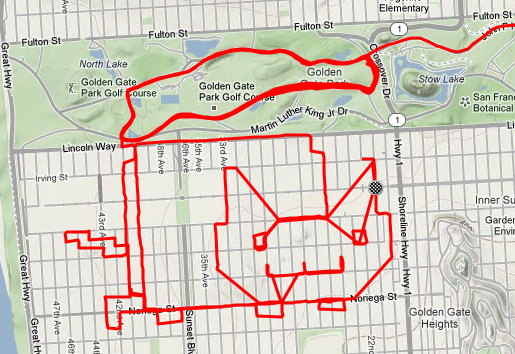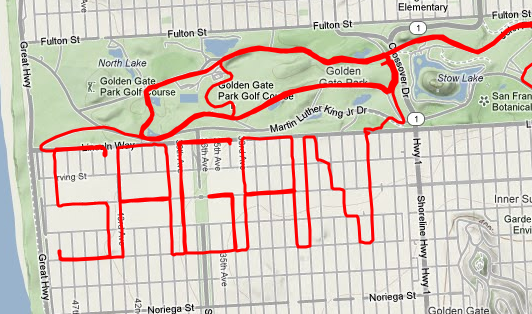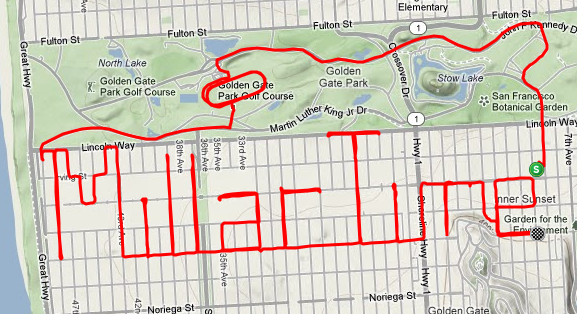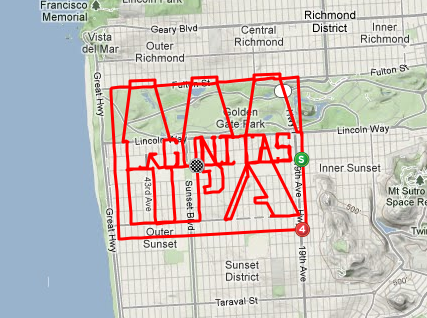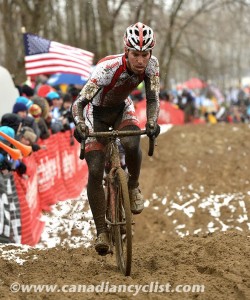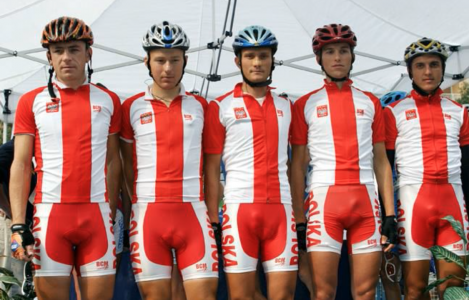 Bike shorts, as with any kind of exercise clothing, the need to be comfortable and do the job you need them to do. Not only should the right bike shorts not pinch when you ride, they need to conform to your body and not shift during the movements you’ll make while cycling. Unfortunately, the best way to find the right pair of shorts will ultimately be to try them on and test them out. This is because everyone’s body is different, so everyone will have a different preference of brand, size, and fit. However, here are a few tips to keep in mind so that the process doesn’t seem so hit or miss. [Read more…]
Bike shorts, as with any kind of exercise clothing, the need to be comfortable and do the job you need them to do. Not only should the right bike shorts not pinch when you ride, they need to conform to your body and not shift during the movements you’ll make while cycling. Unfortunately, the best way to find the right pair of shorts will ultimately be to try them on and test them out. This is because everyone’s body is different, so everyone will have a different preference of brand, size, and fit. However, here are a few tips to keep in mind so that the process doesn’t seem so hit or miss. [Read more…]
Magnetic Bicycle Seat Boosts Male Fertility
A lighthearted look at 3 completely fictional cycling headlines we’d like to see in 2014.
 Doping continued to be the top cycling headline in 2013, with the fallout from Lance Armstrong still trickling through the ranks of elite cycling. The year kicked off with Armstrong sitting down with Oprah Winfrey to share a candy coated version of his career as pharmaceutical guinea pig. If all the bad news in cycling makes you want to cancel your RSS feeds, wait. Here are 3 cycling related news stories we would really like to see in 2014.
Doping continued to be the top cycling headline in 2013, with the fallout from Lance Armstrong still trickling through the ranks of elite cycling. The year kicked off with Armstrong sitting down with Oprah Winfrey to share a candy coated version of his career as pharmaceutical guinea pig. If all the bad news in cycling makes you want to cancel your RSS feeds, wait. Here are 3 cycling related news stories we would really like to see in 2014.
Magnetic Bicycle Seat Boosts Male Fertility
Baltimore(ATP)- Researchers at John Hopkins Medical Center have released results from a study of the potential health benefits of a new magnetic bicycle seat developed by scientists at Japan’s Superconducting Magnetic Levitation Institute. The revolutionary saddle system uses special bicycle shorts incorporating rare-earth magnets and a small wheel mounted generator to enable virtually frictionless pedaling. Anecdotal reports of increased libido and performance by male test riders led to medical researchers at the John Hopkins Sexual Performance Center to launch a study of the new technology’s potential benefits for male fertility. “The faster I rode, the harder it got, amazing!”, reported one study participant.
Center spokesperson, Harold Newsworthy read from a prepared statement, “we are pleased to announce that preliminary results found significant benefits for members of the study group in multiple measurements of fertility and performance, including sperm count, motility, vascular response, and testosterone levels”. Study participants also reported significant improvements in their 10K time trial results.
Federal Lawmakers Pass Major Tax Credit For Bicycle Commuters
(Associated Cycling News) – Federal lawmakers today passed sweeping tax reforms aimed at encouraging energy conservation and the use of environmentally friendly transportation alternatives. People that bicycle to work were the big winners. Cycle commuters will earn tax credits equal to the cost of bicycle equipment, maintenance and repair, as well as a 47 cents per kilometer mileage credit. Tax expert, Tex Vader estimates the average annual credit could be as high as $10,000.
Environmental activists and urban livability lobby groups have both applauded the move. Vision Green director, Sam Ting and Better Urban Resources Board (BURB) spokesperson Chloe Dupé both congratulated the government for it’s positive vision and proactive initiative. Funds for the credit are being generated from a new $10 a month tax on parking stalls.
Beer Rates As #1 Cycling Workout Recovery Beverage
Munich (Beer News Network) – In a groundbreaking study from Munich State University sponsored by the Bavarian Brewers Association, researchers have found that beer provided the most rapid restoration of electrolyte and blood sugar levels following intense cycling workouts. The study compared various popular exercise recovery strategies including sports drinks, energy drinks and milk thistle mixed with buttermilk and lemon juice. Beer was a clear winner for exercise recovery while the milk thistle mix did perform well on the following day’s hangover test.
Researchers described the test results as promising but added that a larger study was needed to better define the optimal fluid replacement regime. Volunteers for the expanded test are actively being sought. Interested participants will be required to relocate to the study center in Munich, Germany for the month of October.
What would you like to read about in 2014? Comment below:
Why We Love Cycling
Cycling… Our Drug of Choice
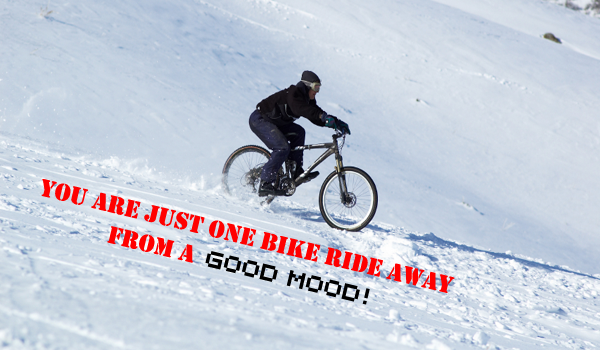 Cycling is our therapy
Cycling is our therapy
You can’t help but smile
The more you ride, the more you get to eat
The feeling of flying
Wind blowing in your hair
Staring at peoples butts in spandex
Your butt looking good in spandex
Ride more, feel better
The inevitable endorphin kick
Beautiful people inside and out
The RUSH
The freedom you feel
The first spring ride after a long cold winter
Wiping away the tears because you are going so fast
Going all out
Blowing your first successful snot rocket
Group rides
Dropping someone
Waiting at the top of a hill for everyone to catch up
The energy that surges through you
Mode of transportation
Family rides
Racing and suffering with your friends
The mental ecstasy
The friendships it creates
Clean energy
Winning your first race
The challenge
Being absolutely gutted after a climb
Tailwinds
The feeling you have just before you take a drop that is out of your comfort zone
Pushing over 1000 watts (even if it is only for a second)
Suffering never felt so good
Jello-y legs
Being a part of such an amazing community
This is why we love cycling! Why do you ________________ ?
The Perfect Sprinting Technique
The Perfect Sprinting Technique
To be a great sprinter not only do you need great tactics but you need the perfect sprinting technique.
Choosing the Proper Gear
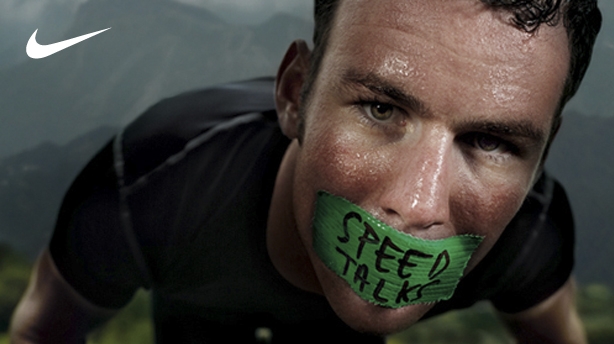 Before you can even begin to sprint it is crucial to select the proper gear, it has to be one that you can accelerate very quickly, but not one that you are going to spin out of too soon. Gear selection will come with practice. Challenge yourself to mini sprints while on training rides to get a better feel for gear selection.
Before you can even begin to sprint it is crucial to select the proper gear, it has to be one that you can accelerate very quickly, but not one that you are going to spin out of too soon. Gear selection will come with practice. Challenge yourself to mini sprints while on training rides to get a better feel for gear selection.
A more advanced technique to keep in mind is that suddenly changing gears can signal to people that you are about to get up and sprint, so try to soft pedal for a moment and then feather the gear change if you are trying to catch them off guard.
The Jump
Once you have selected the proper gear it is time to start the sprint. Wait until your “power foot” (likely your right foot if you are right handed) reaches the 2 o’clock position then get out of the saddle, push down on the pedal and go like a bat out of hell. To generate the maximum amount of explosive power you should be pulling down on your drops while pushing down on your pedals. Use your weight to your advantage and rock the bike side to side so that your weight is over the pedal on each down stroke. The first 5 pedal strokes should be extremely explosive.
Sprinting
Now that you have started to sprint it is important to keep technique top of mind. Keep your body low and elbows in as much as possible as you continue to accelerate. You are able to go faster with the same amount of power if you are more aerodynamic as the air resistance increases exponentially as speed increases. Keep your upper body quiet, low and focused on where you want to go.
If you are not racing for the line, look back once or twice to make sure you have created enough of a gap to continue to breakaway but do not keep looking back. Find a steady hard effort and continue to push.
Changing Gears
Ideally in a sprint finish you have selected the proper gear to use the entire sprint; however, in a breakaway sprint you may need to change gears once you have created the gap. Changing gears effectively while standing takes a lot of practice, so it is a good skill to hone in while you are out training.
Tactics
Tactics is a whole other art that is equally as important as the perfect sprinting technique. Stay tuned.
How To Be a Road Biker
How To Be a Road Biker
NSMB.com put together another hilarious video on the 26 steps on how to be a road biker.
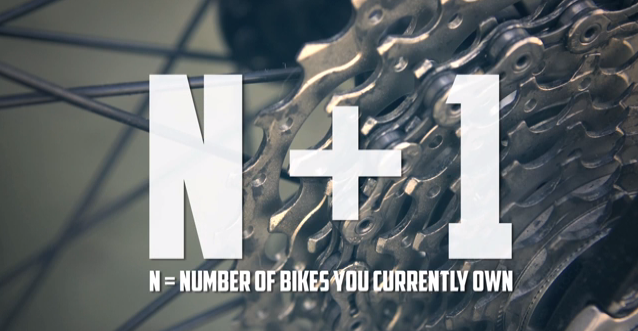
If you liked this one check out How To Be a Mountain Biker
Four Steps To Avoid Overtraining
Four Steps To Avoid Overtraining
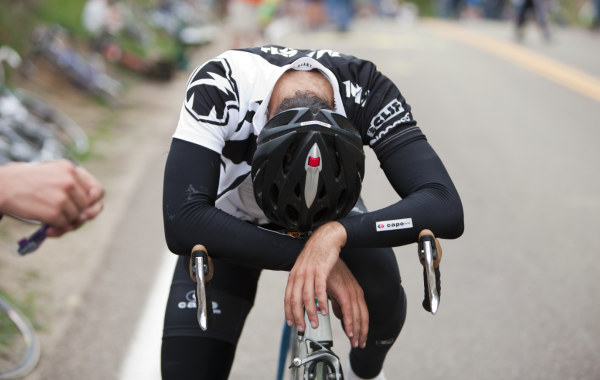 Anyone can suffer from overtraining and in fact, it’s more likely to occur in beginner cyclists as they try and do too much, too soon.
Anyone can suffer from overtraining and in fact, it’s more likely to occur in beginner cyclists as they try and do too much, too soon.
As you go about doing your regular cycling sessions, one thing that you do need to keep yourself very aware of is the concept of overtraining. Some people mistakenly believe that overtraining will only happen to serious athletes and top notch cyclists who are training for hours each day, but this just isn’t the case.
To help ensure you are doing everything you can to prevent overtraining, let’s look at four steps you should take.
Sleep Well
First, one of the top things that you must keep in check is your sleep needs. If you are not sleeping enough each evening, this is going to sacrifice the recovery you make between rides and will most definitely put a dent in your recovery.
You should be sleeping at least 7 hours, preferably 8 or more during intense training times.
Take At Least One Off Day and A Cross Training Day Each Week
Second, it’s also important that you take at least one day off each week to allow for complete rest and recovery. Don’t exercise 7 days a week or you are on a fast road to overtraining. Remember, your body needs time to recover, so don’t be afraid to give it that time.
In addition to that, you would be best suited to doing a day of cross training as well at a moderate intensity level. Go for a swim or take a leisure walk with a friend. There are many ways to move and keep up your fitness without it being an intense ride.
Don’t Fear Carbohydrates
Make sure that you are eating enough carbohydrates as well. If weight loss is your goal, you may be cutting back on this particular nutrient quite readily in your diet, but that will set you up for some problems down the road. As your glycogen stores become more and more depleted, you will notice that it becomes harder and harder to do the rides you set out to do. Eventually, high amounts of fatigue will set in and when they do, your rides will cease to exist. Overtraining will set in and you’ll be required to take time off.
The most important times to consume carbohydrates are during your rides (especially ones at high intensity) and immediately after rides. After you have replenished the glycogen and carb stores you can go back to your paleo diet that is low in carbs or The Paleo Diet for Athletes.
Assess Your Stress
Finally, be sure that you assess your stress levels. Remember that it’s not just exercise stress that can add up and impact your cycling performance. You can also start to experience stress from relationship, financial, or work related issues and this can wear you down as well. You want to keep your life as stress free as possible and that will go a long way towards helping you avoid overtraining.
So keep these quick tips in mind and you can forge onward and put the risk of overtraining behind you.
Maximizing Your Performance
Maximizing Your Performance
This training article comes courtesy of Leah Guloien and Jamie Riggs, General Managers of the Cycling Division at Burnaby’s Catalyst Kinetics Group.
1. “What’s holding you back?”
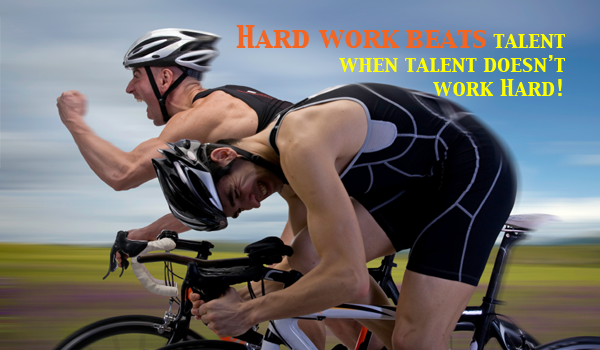 Answering this one question, and developing a strategy to turn that weakness into strength, will pay dividends with faster times and stronger rides. Most athletes, for example, never consider they’re breathing? Many athletes breathe with quick shallow breaths, which not only wastes energy, but also hinders your bodies’ ability to burn fat as fuel. Taking 5 minutes per day before bed to practice ‘belly breathing’ is one of the simplest and quickest things an athlete can do to change their performance. To do it, lie on your back in a relaxed position, and place one hand on your abdomen. Now focus on taking deep breathes using your diaphragm, if you’re doing it right your belly will be moving up and down quite a bit. If you feel yourself tensing any neck muscles, stop, and refocus on breathing from the belly. A few minutes a day, and you’ll be started down the path towards becoming an efficient breathing machine!
Answering this one question, and developing a strategy to turn that weakness into strength, will pay dividends with faster times and stronger rides. Most athletes, for example, never consider they’re breathing? Many athletes breathe with quick shallow breaths, which not only wastes energy, but also hinders your bodies’ ability to burn fat as fuel. Taking 5 minutes per day before bed to practice ‘belly breathing’ is one of the simplest and quickest things an athlete can do to change their performance. To do it, lie on your back in a relaxed position, and place one hand on your abdomen. Now focus on taking deep breathes using your diaphragm, if you’re doing it right your belly will be moving up and down quite a bit. If you feel yourself tensing any neck muscles, stop, and refocus on breathing from the belly. A few minutes a day, and you’ll be started down the path towards becoming an efficient breathing machine!
Fitness testing is another way to examine your current performance level. At Catalyst Kinetics Group we start every athlete off with a comprehensive physiological assessment, which quantifies every aspect of your performance, from your breathing frequency and cardiac function, to blood values and muscle oxygen saturation. These types of assessments require expensive equipment and knowledgeable people to run them, but you can get a great start on your own with nothing more than your bike, a stopwatch and a heart rate monitor. See below for an example of a field test we use to build an athlete’s training program.
Fitness test: After a 30-minute warm-up, pick a straight, relatively flat stretch of road that you can ride at least 20 minutes with a minimum of stops. Start your watch and ride a 20-minute time trial, making sure to record power (if available), heart rate, and speed along the way. Record these numbers for later, and see below for some ways you can use them to build workouts.
2. “Have a plan”
It’s been said a million times, but this simple advice will pay off for anyone with ambitious cycling goals. It can be as simple as writing out the ‘Fondos, races, and rides you hope to do this year on a calendar, and taking a look at the spacing between them. This can have surprising results, as maybe you weren’t aware exactly how close together those two massive rides you were planning were, or didn’t notice a gaping hole with no events just waiting to be filled.
Once you have your main events penciled in, go through and mark out your next most important training periods, the easy ones! A big ride, race or Fondo take a lot of energy, both physically and mentally, and it can be easy to ride the wave of endorphins that comes from completing one of these events into another hard week of training. The result is that you find yourself in a deep ‘hole’ of fatigue, with that next big ride looming on the horizon. So after each big goal event, be sure to schedule an easy week of training, and from there you can start to rebuild toward your next personal best.
3. “Keep the easy stuff easy, and the hard stuff hard”
One of the most important benefits to having a plan laid out in advance is that you are in effect giving yourself a reason to go easy sometimes. If every ride you head out with no idea about what you have done or what’s up ahead, it is very easy to fall into the dreaded ‘junk mile’ trap. These rides feel great. You’re pushing the pedals, working up a sweat, as well as an appetite. But then you notice that no matter how much you ride, you aren’t losing any weight, or that no matter how fast the average speed on that three hour Saturday ride, you’re still getting creamed in the local group ride sprint.
Instead of pushing it every day, arrange your weekly rides so that a few, no more than two, are your hard rides. The rest of the time on the bike should be spent at a pace where you can easily hold a conversation with a person beside you. These rides truly do lay the base of fitness, logging time in these easy zones allows your body to adapt structurally to the load being applied. More blood vessels, increased density of cellular powerhouses, and a whole raft of other changes that turn your body into a super efficient, fat-burning, watt-churning machine.
Example Structural Endurance Workout: Ride for two hours at a ‘conversational’ pace, keeping your cadence between 85 to 95 RPM. Every 15 minutes do a short, 15-second sprint, and finish with 5 to10 minutes at 110 RPM.
The two hard days are the chance for you to explore your limits. Since you won’t be as tired as you would have been had you been riding ‘medium’ all the time, your hard efforts will be truly hard, taking your legs and lungs up to their maximum capacity. By pushing against the limits of what you are currently capable of, you will see your ability to sprint and hang on to the fastest guys in town increase dramatically. Thirty-second all out intervals are all the rage lately, but in reality there is no end to the sessions you can dream up. Whether they’re short sprints or longer five and ten-minute efforts, they all have a place in a well-rounded cyclist’s plan.
Example Short Interval Workout: Start out with a 30-minute warm-up, gradually increasing your effort level. Include one, 8-minute interval at an effort level of 8 out of 10 during this warm-up. Next, proceed to do six 30-second maximal efforts, staying in the saddle as much as possible, ‘spinning’ rather than ‘mashing’ the pedals. Leave at least four minutes of very easy spinning between efforts. Finish the workout with another 10 minutes at an effort level of 8 out of 10.
Example 10 minute Interval Workout: Take the average power you found during the 20-minute field test (see above), and multiply it by 0.85 and 1.05. These two numbers will become your high and low-end thresholds. During a 2-hour ride, do two intervals of 20 minutes each, alternating 3 minutes at the low-end threshold, with 2 minutes at the high-end threshold power. If you don’t have access to a power meter, you can also use average heart rate, adding and subtracting five beats to your average during the field test to find the high and low end threshold values.
4. “Take care of your body”
Addressing muscular imbalances and inefficiencies on the bike, whether it is as a result of habitual patterns that the body has become accustomed to or as a result of an incorrectly fitting bicycle can assist in helping you achieve your optimal performance.
Designing a pre- and post-cycling routine can help set you up for success. Purchase a foam roller to help with muscle activation and localized tension within the muscles. The glutes and the quadriceps are important areas to focus on. Some specific exercises we like to incorporate prior to our PowerRide sessions are planks, thoracic spine openers and bridges. Activating the core, opening up through the chest, and activating the glutes are all-important to a strong posture and alignment on the bike.
After intense or long sessions on the bike, it is important to cool the body down properly and not only in the sense of pedaling easier. Making sure to stretch out the body and return the body back to an ideal posture is important. Stretches such as spinal twist, pigeon pose, and downward dog are all great stretches post cycling. Take 10 minutes and pick 5 to 10 stretches and hold each for approximately 30 to 60 sec, always easing into the stretch and never pushing to the point of pain.
We hope you’ve been able to learn something helpful from this article, and wish you nothing but the best in pursuing your cycling goals.
Leah Guloien and Jamie Riggs are General Managers of the Cycling Division at Catalyst Kinetics Group, a Vancouver area, multi-disciplinary health clinic, physiological assessment and sports & fitness training facility.
Thinking of doing a Granfondo this year? Check this one out: Okanagan Granfondo
Strava Art
Strava Art
Chris Phipps has created some amazing Strava Art:
People often ask if I plan these out or not. When the piece includes words I don’t plan because the letters are pretty easy to make, especially since I learned the trick of doing diagonals. However, for pictures such as the Nyan Cat and the Lagunitas IPA 6 pack, I first do a sketch on a printout map of San Francisco, mostly to make sure I don’t run into any parks or schools that block the grid.
It started on January 14, 2012. I was listening to the 49ers vs. Saints playoff game on the radio while riding laps at the polo fields. The 49ers were underdogs, but scored 2 touchdowns in the 1st quarter to go up 14-0, so I was inspired to ride out to the Richmond district and do this.
I received a lot of comments and kudos on the ride, so I did this ride before the NFC championship game vs. the NY Giants the following week.
…But they lost & didn’t make it to the Superbowl, so I didn’t do anything for that.
I didn’t do anything for a while, but during the Tour de France, I was inspired to write“SAGAN” after his stage win on July 3rd.
On the 4th of July, I tried to do a flag, but had to have the stripes go north to south due to the grid layout in the Sunset (a neighborhood in San Francisco, California).
The ride that got me the most kudos and attention was my tribute to David Millar’s win on July 13. Millar replied to my tweet and started following me on Twitter for a while.
Recently, I’m just training in the city and if someone asks me to try something such as Nyan Cat I will. Or if something else inspires me, I’ll do a ride. Last Thursday I found out it was National IPA Day, so that led to the Lagunitas ride. As for future plans, I’m having fun with this and definitely want to try some larger and more elaborate drawings, but probably not until my racing season is over with Masters Nationals in Bend next month.
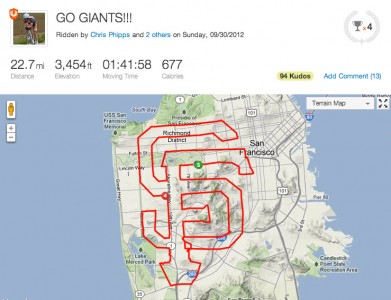
Strava Art from Others:
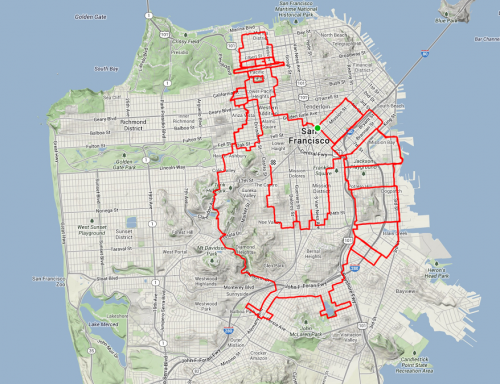
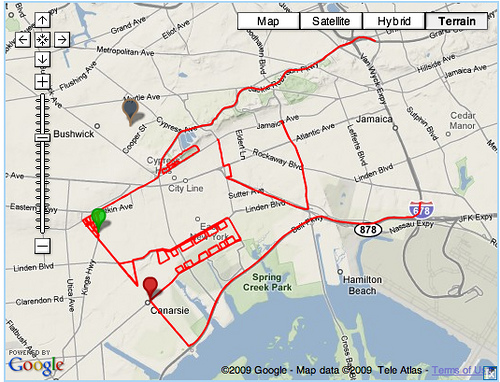
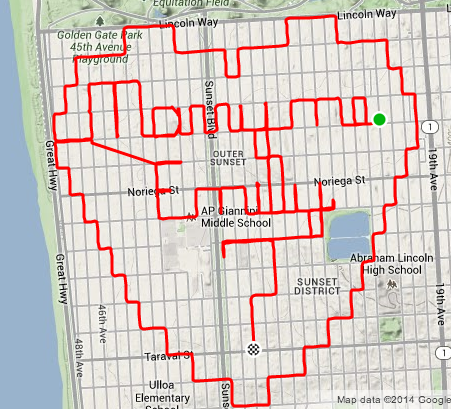
Thanks to Strava for providing the story above
5 Winning Cyclocross Tips
5 Tips For a Successful Cyclocross Season
If you were disappointed with how you raced last cyclocross season, had some issues with your cx skills, or simply felt you could have been faster, then these simple (and in many cases obvious) tips can make your next season a winning one.
1. Ride Your Cross Bike 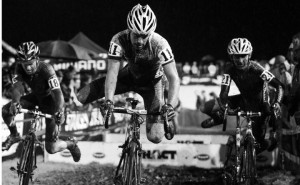
If you are serious about cyclocross you should not touch your road bike all cyclocross season, and limit your time on a mountain bike. Also mix in cyclocross rides during the spring and summer so you don’t look as shaky as a new born baby deer when you do a cross dismount in August. Most elite cross racers will mix in some cyclocross rides in the off-season, riding the bike more starting in July, and exclusively by September. Most racers will have a set of wheels mounted with road tires for their cross bike for training on the road and group rides. When you spend a lot of time on a bike it starts to feel like an extension of your body and becomes very predictable both on and off road. Predictable equals fast.
2. Do Your Cyclocross Workouts Off-road
When you start doing cross specific workouts and intervals make sure to do them off-road on mini-cross courses. It is easy to get sucked into wanting to do your intervals on the road where you can hit predictable power numbers, but in a cross race you are going to have to put power down on bumpy, slippery, and twisty terrain. Make your cross workouts into real cross workouts and do them off-road
3. Learn Proper Cyclocross Technique
Having proper technique for carrying, dismounting and mounting your bike in all different scenarios not only makes you a faster more efficient rider, but also cuts down on mechanical issues because you are not banging the bike around. Sadly many amateur riders have some holes in their technique and enrolling in a cyclocross skills clinic is the best way to fill those holes.
4. Strengthen Your Core
Cyclocross has a lot of weird unbalanced repetitive motions such as jumping on and off your bike from the same side as well as always carrying your bike on the other side. These repetitive motions can lead to weird and debilitating overuse injuries.
5. Take an Off-season
If you race cross all fall it is easy to jump into training for the upcoming road or mountain bike season after only a few weeks rest. For most people your body and soul need more than a few weeks rest. Take the time to recharge and do some other activities. Here is a list of the most popular off-season activities for cyclists.
Craig Richey is a multiple time Canadian National team member, representing Canada at mountain bike World Cups and cyclocross World Championships. Craig is currently doing an MBA in Boston and recently launched SponsorConnected.com
How To Stay Cool While Cycling
How To Stay Cool While Cycling
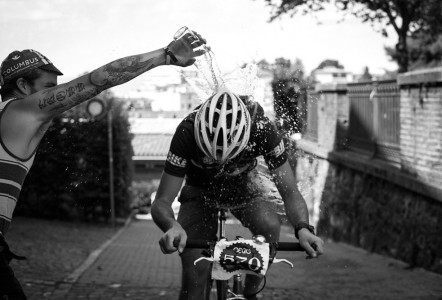 The summer heat can press down on you like a sweaty blanket learn how to stay cool while cycling.
The summer heat can press down on you like a sweaty blanket learn how to stay cool while cycling.
What Do You Wear to Stay Cool?
One of the most important considerations is what you are wearing on days where you are cycling in the heat. It’s important to wear clothing with the following traits:
- Light colored – to reflect away the sunlight. I now only buy white jerseys because I am very prone to overheating.
- Wicking – to move sweat away from your skin and to the outer surface where it can evaporate.
- Zippers – so you can unzip and catch a nice breeze.
Another way… wear as little as possible. While this could keep you cooler, it also opens you up to sun damage. However, there is something to be said for at least keeping your arms and shoulders bare as these are places where your axillary arteries are. Axillary arteries carry cooled blood back to the heart to cool the rest of your body, so it’s worth keeping them exposed if possible.
Accessorize
Accessories are not just for looks, they are for functionality as well:
- Sunglasses – a surprising amount of heat can be absorbed through your eyes. Keeping the sun out, as well as bugs and dirt, will keep you cooler.
- Helmet – pay a little extra for well ventilated helmets, no one enjoys heat stroke.
Water
Not only do you need to stay well hydrated, but you should keep extra water to soak yourself. Take advantage of those big vents you paid extra for on your helmet and spray some water down them. Keep your head cool first, and if you have enough to spray under your armpits, near your groin and down your back as these are the places that your blood vessels are close to the skin.
Sunscreen
I used to hate wearing sunscreen, but I noticed a major improvement in performance when I slapped it on… now I don’t leave home without it. I have read that applying sunscreen can keep your body temperatures 10% cooler.
Avoidance
Take a look at the forecast and if you know it is going to be hot, ride in the morning/evening when you don’t have to battle the heat.
A little common sense goes a long way in the heat. If you start to feel woozy or start overheating stop and take the time to cool down because heat stroke can kill you or cause permanent damage to your brain and internal organs. It is serious stuff… so stay cool.
